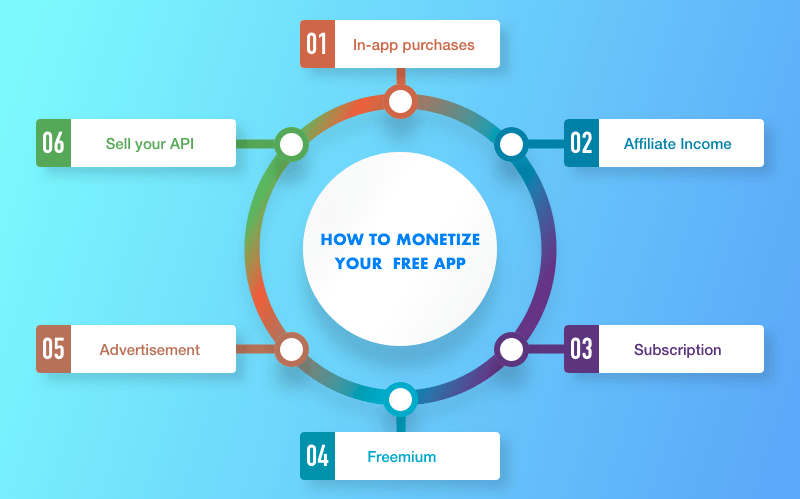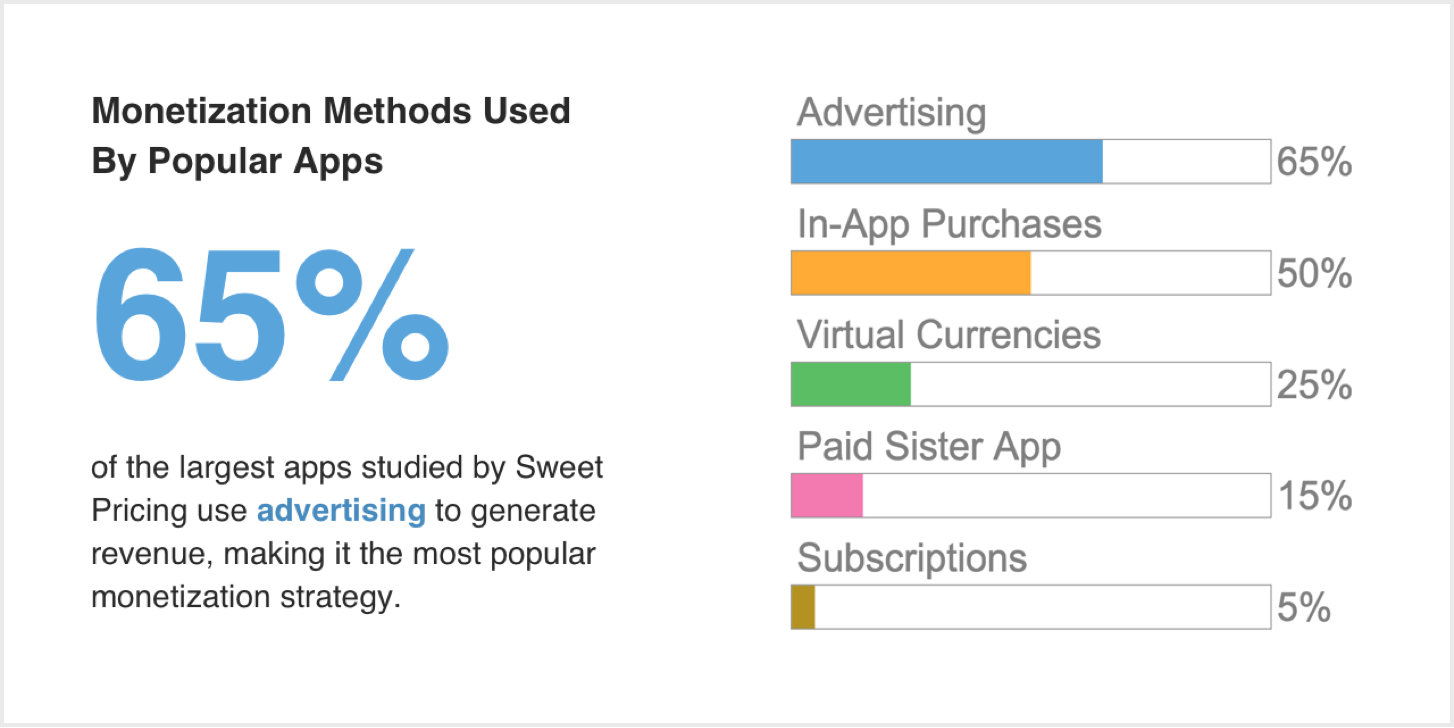How Apps Make Money Without Ads: Unveiling Lucrative Strategies
In a rapidly evolving digital landscape, app developers are constantly exploring innovative ways to generate revenue beyond traditional advertisements. The question of “How do apps make money without ads?” has sparked curiosity among developers and entrepreneurs alike. This article delves into various strategies that apps employ to monetize their platforms without relying on ads. We’ll explore a wide range of methods and success stories that shed light on the possibilities of app monetization.

What is app Monetization?
App monetization is the process of generating income from a mobile application. It is a crucial consideration for app developers and business owners seeking to establish sustainable revenue streams. While the most common method of app monetization involves displaying advertisements, it’s important to recognize that users often find ads annoying and intrusive, which can lead to reduced user retention and engagement. Therefore, exploring alternative approaches to app monetization without ads may be a more user-friendly and effective strategy.
How Much Do Free Apps Earn?
Do people spend money when using a free app? As of the second quarter of 2023, the average consumer spend on mobile apps per smartphone was of approximately 5.03 U.S. dollars, down from the 5.31 U.S. dollars spend on average by global users during the first quarter of 2021. This figure showed a slight decline from the $5.03 spent on average by global users in the first quarter of 2022. Notably, the majority of this spending occurs within mobile games when compared to other categories of mobile apps.
In 2022, apps available on Apple’s App Store generated a staggering $86.8 billion in revenue, while those on the Google Play Store brought in $42.3 billion. It’s worth noting that over 90% of the apps available on both of these platforms are offered as free downloads. This suggests that a substantial portion of the revenue in the mobile app ecosystem is derived from free apps.
To put this into perspective, consider the popular first-person shooter game Fortnite, which generated an impressive $5.8 billion in revenue in 2021 solely from in-app purchases. When we compare this to a non-game app like Slack, a widely-used communication tool, it recorded earnings of $273.4 million in the first quarter of 2022. These figures highlight the vast differences in revenue potential between gaming and non-gaming apps.
The Importance of App Monetization for App Owners
“App monetization plays a pivotal role for app developers and business owners in establishing sustainable revenue streams. Here are several compelling reasons why it holds such importance:
- Revenue Generation: App monetization strategies enable app developers and business owners to generate essential revenue. This income is critical for covering the costs of app development, compensating employees, and ultimately, achieving profitability.
- Enhanced User Experience: Opting for app monetization without relying on ads empowers app creators to enhance the user experience. By removing intrusive and bothersome ads, which can negatively impact user retention and engagement, the overall quality of the app improves.
- Increased User Engagement: App monetization tactics like in-app purchases and subscription-based models can boost user engagement significantly. They do so by offering exclusive content and features that users find valuable enough to pay for, thereby increasing their level of interaction with the app.
- Building Brand Loyalty: Certain app monetization strategies, such as sponsorships and collaborations with brands, assist app developers and business owners in building brand recognition and loyalty. By aligning with relevant companies and promoting their products or services, these strategies create a win-win scenario for both the app and the brand.
While app monetization is crucial for most app owners, there are cases where abstaining from displaying ads proves to be a more effective approach in terms of maintaining stable revenue and preserving the user experience.”
How Do Apps Make Money Without Ads?
Apps have revolutionized the way we live, work, and entertain ourselves. As the app market grows increasingly competitive, developers have harnessed their creativity to uncover alternative revenue streams. Here are some of the most successful strategies for generating income without resorting to ads:
In-App Purchases: Enhancing User Experience and Profits
In-app purchases have become a cornerstone of app monetization. By offering users additional content, features, or virtual goods, apps can enhance the user experience while generating revenue. Popular games often use this strategy, allowing players to buy power-ups, levels, or cosmetic upgrades.
Monetization Strategies Without Ads
Following are the list of Monetization strategies without ads.
The freemium model has become increasingly popular and prevalent in today’s app ecosystem, particularly in the Google Play Store and Apple App Store. This approach is designed to strike a balance between offering a basic version of the app for free while providing the option for users to pay for advanced features and functionality. By doing so, it aims to attract a larger user base initially and then generate revenue through upselling premium offerings.
Here’s a closer look at how the freemium model works and the various monetization strategies associated with it:
- Basic Functionality for Free: Freemium apps typically provide users with access to a basic version of the app at no cost. This basic version usually includes essential features and services, making it attractive to a wide audience.
- Premium Features for a Fee: To unlock more comprehensive and advanced capabilities within the app, users are encouraged to pay a fee. This fee can take various forms, depending on the type of app and its target audience.
- Monetization Strategies:
In-App Purchases: This strategy is commonly used in mobile games, where users can buy virtual items, currency, or upgrades within the app. These in-app purchases enhance the gaming experience or provide competitive advantages.
Subscription Model: Many productivity apps, as well as services like Skype, adopt a subscription-based approach. Users pay a recurring fee (monthly or annually) to access premium features or to remove limitations on the app’s functionality. This can be an effective way to generate a steady stream of revenue.
- User Acquisition and Retention: The freemium model is ideal for reducing user acquisition costs because it lowers the barrier to entry. Users can try out the app without an upfront payment, increasing the chances of attracting a larger user base. The goal is to convert some of these free users into paying customers over time by providing value and enticing them with premium features.
Examples:
- Skype: Skype employs a subscription model for its Skype To Go service, where users pay for the ability to make international calls at lower rates. Additionally, Skype sells credits that allow users to access certain premium features or make calls to non-Skype numbers.
- VSCO: VSCO, a popular tool for photo and video creators, offers a free app with limited features. It also provides a premium subscription that unlocks a range of advanced editing tools and features, appealing to serious photographers and content creators.
In conclusion, the freemium model has become a dominant force in the app market by offering a compelling value proposition to users while providing opportunities for app developers to monetize their offerings effectively. It’s a strategy that balances user acquisition with revenue generation, making it a favored approach for many app developers today.
2. Subscription Services: Creating Recurring Revenue
Subscription-based apps have become a popular monetization strategy, particularly in industries that can provide continuous value and content to users. Let’s delve into the subscription model and how it works for free apps:
Subscription Model:
- The subscription model involves charging users a recurring fee on a monthly or annual basis to access the app’s premium features, content, or services.
- This approach is effective for apps that can consistently provide fresh and valuable content or services, ensuring that users find ongoing value in their subscription.
- Subscription-based apps often build a loyal customer base over time, as users commit to regular payments in exchange for continuous benefits.
Industries that Benefit from Subscriptions:
The subscription model is commonly employed by apps in the following industries:
- Streaming Platforms: Video, audio, and content streaming services like Netflix and Spotify offer subscription plans to access a vast library of media content.
- Fitness Apps: Apps offering personalized workouts, training plans, and health monitoring often use subscriptions to provide users with ongoing fitness guidance.
- News Aggregators: News apps can offer ad-free experiences and access to premium articles through subscription plans.
- Software as a Service (SaaS): Business apps and productivity tools often offer subscription pricing for premium features and support.
Benefits of the Subscription Model:
- Steady Revenue: Developers using the subscription model can rely on a consistent stream of revenue as long as users maintain their subscriptions. This predictability can be advantageous for financial planning.
- Customer Loyalty: Subscribers are more likely to remain loyal to the app, as they have a financial commitment. This can result in lower churn rates compared to models where users pay one-time fees.
- Continuous Value: The subscription model encourages developers to continually improve and update their app to keep subscribers engaged with fresh content and features.
Encouraging Sign-Ups:
- To entice users to sign up for subscriptions, some apps offer trial periods or money-back guarantees for new users. These introductory offers can lower the barrier to entry and allow users to experience the app’s premium features.
- Clear communication of the value users will receive from the subscription is also crucial in encouraging sign-ups.
Examples:
- Netflix: Netflix is a prime example of a subscription-based app in the streaming industry. Users pay a monthly fee to access a vast library of movies and TV shows.
- Spotify: Spotify offers both free and premium subscription tiers, with the premium subscription providing ad-free listening, offline downloads, and unlimited skips.
In summary, the subscription model is an effective way for free apps to generate revenue by providing continuous value to users. While it may not be the most popular monetization approach, it can be highly successful for apps in industries that can sustain ongoing engagement and deliver compelling content or services.
3. Selling Digital Goods: Unlocking Virtual Marketplaces
Apps employ various strategies to generate revenue, and one common approach is to offer both free and paid versions. This strategy allows users to access basic features at no cost while requiring payment for more advanced or premium functionalities. Here’s a closer look at how free apps make money using this model and some examples:
Free and Paid Versions:
- In this model, apps provide two versions: a free version with limited features and a paid version with additional capabilities.
- The free version typically includes basic functionalities to attract a broad user base, while the paid version offers more advanced tools or removes limitations.
- Users can choose to make one-time in-app purchases or subscribe to unlock premium features.
Types of Apps Using This Model:
- Work Optimization Apps: These include project management systems, professional platforms, and messengers. Users often get basic features for free and can upgrade for enhanced productivity and collaboration tools.
- Content-Based Apps: Apps with useful or entertaining content may offer some content for free and charge for premium content or ad-free experiences. This approach is seen in educational apps, media apps, and more.
- Dating Services: Dating apps often provide free basic features like profile creation and browsing, while premium features like unlimited swipes or enhanced visibility require payment.
- Health and Fitness Apps: Fitness apps frequently offer basic workout plans and features for free, with the option to purchase premium workout programs, personalized coaching, or advanced tracking capabilities.
- Travel Guides and Navigators: Travel apps may provide basic navigation services for free and offer paid features such as offline maps, travel recommendations, or premium guides.
- Cloud Storage: Cloud storage apps offer limited free storage space and charge for additional storage capacity.
Examples:
- Slack: Slack, a corporate messenger, offers a free version with basic features suitable for small projects. It allows users to store a limited number of messages and attachments. Paid plans provide expanded storage, video conferencing, and integrations with other applications, catering to larger organizations’ needs.
- Workout Trainer: This fitness app offers a free version with photos, voice instructions, and a workout timer. Users can upgrade to a premium version for video workouts and comprehensive workout programs spanning several weeks.
- Trello, Asana, and Jira: These project management apps follow a similar model. They offer free versions for small teams or projects and charge for advanced features, larger teams, or additional functionalities.
Challenges and Success Factors:
- A potential challenge with this model is ensuring that the free version provides enough value to attract users while enticing some to upgrade.
- Effective analytics and understanding your target audience’s willingness to pay are crucial for offering relevant paid services.
- Striking the right balance between free and paid features is essential to maximize revenue without alienating users.
In summary, offering both free and paid versions is a versatile monetization strategy that allows apps to cater to a wide range of users while generating revenue from those who seek enhanced features or premium content. Careful planning and user feedback can help optimize this model for success.
4. Affiliate Marketing: Leveraging Partnerships for Profit
Affiliate marketing and advertising are two prominent strategies that free apps often utilize to generate revenue. Let’s delve into these methods in more detail:
Affiliate Marketing:
- Affiliate marketing involves promoting products or services from third-party companies within your app.
- Developers earn a commission for every user who makes a purchase through the app’s affiliate links.
- This strategy works particularly well for apps that cater to specific niches or industries, as it allows them to target a relevant audience with relevant products or services.
Advertising:
Advertising is a widely adopted monetization strategy for free apps and comes in various forms, including:
Cost Per Mille (CPM):
In the CPM model, app developers are paid based on the number of ad impressions. An impression occurs each time an ad is displayed to a user.
This method can be effective for apps with high user engagement and a large user base.
Cost Per Click (CPC):
CPC advertising generates revenue based on the number of clicks delivered through the ads. Developers earn a fee for each click on the ad.
It incentivizes advertisers to create compelling ad content to encourage clicks.
Cost Per View (CPV):
CPV monetization involves earning money based on the number of views by app users. This is often used in video advertising, where users watch short video ads.
Developers receive payment when users engage with the ad by watching it.
Cost Per Action (CPA):
CPA advertising is based on specific user actions, such as installing an advertised app or making a purchase through a provided link.
Developers earn a commission when users complete these predefined actions, which can be highly lucrative.
It’s important to strike a balance when using advertising as a monetization strategy in free apps. While ads can generate revenue, excessive or intrusive ads can negatively impact the user experience and may lead to user churn. Thus, app developers should carefully consider the placement and frequency of ads to ensure they enhance rather than disrupt the user experience.
Examples:
Duolingo: Duolingo, a language-learning app, uses advertising as one of its monetization strategies. Users can opt to watch short video ads to earn in-app rewards or a premium version of the app without ads.
Instagram: Instagram incorporates advertising through sponsored posts and stories. Businesses and brands pay to have their content promoted to Instagram users based on their interests and demographics.
In summary, both affiliate marketing and advertising are effective ways for free apps to generate revenue. The choice between these strategies often depends on the app’s niche, target audience, and user engagement levels. Additionally, careful consideration of the user experience is crucial to maintain a positive relationship with users while monetizing through advertising.
5. Sponsored Content and Partnerships: Monetizing Influence
Influencer-driven apps and socially important nonprofit projects employ unique monetization methods to generate revenue. Let’s explore these approaches and provide examples of companies that use them:
Influencer-Driven Apps:
Sponsored Content and Partnerships:
Influencer-driven apps collaborate with brands to create sponsored content or partnerships. They leverage their user base and engagement to promote products or services.
Brands pay the app for exposure to the app’s audience, and revenue is shared between the app and the brand.
This strategy can be effective for apps with a strong influencer presence or a community of engaged users.
Examples:
- Apps in the beauty and fashion space often collaborate with influencers to promote makeup products, clothing lines, or skincare brands.
- Social media apps may partner with celebrities or online personalities for sponsored posts or live streaming events.
Socially Important Nonprofit Projects:
Sponsorships:
Socially important nonprofit projects often rely on sponsorships from individuals, corporations, or foundations to fund their initiatives and digital products.
Sponsors provide financial support to the nonprofit organization, including funding for the development and maintenance of mobile apps.
The app serves as a platform to engage supporters, raise awareness, and facilitate donations.
Examples:
World Wildlife Fund (WWF): WWF, a prominent environmental organization, has several mobile applications, including “WWF Amazing Planet.” They receive support from major sponsors, both individuals and corporations, to fund their conservation efforts and educational apps.
Crowdfunding:
Some nonprofit apps engage in crowdfunding campaigns to secure funding for their projects. Crowdfunding allows them to collect donations from a broad community of supporters.
Apps may use crowdfunding platforms to raise money for specific initiatives or to support ongoing operations.
Examples:
Life Gift Fund: The “Life Gift” fund app facilitates coordination between volunteers, blood donors, and donors who contribute to charitable causes. The app earns money through donations, which are used to support the foundation’s resources and initiatives.
While the nonprofit segment’s monetization methods are relatively limited compared to commercial apps, they play a crucial role in supporting socially important initiatives. These organizations often rely on the generosity of sponsors, crowdfunding, and donations to fund their digital products and drive their missions forward.
If you have a socially important initiative and are considering the development of a mobile app, exploring these monetization methods, such as sponsorships and crowdfunding, can help you secure the necessary resources to make a positive impact on your cause.
Crowdfunding: Engaging the User Community
Some apps turn to crowdfunding platforms to generate revenue. By offering exclusive rewards or features to backers, developers can fund ongoing app development while involving the user community in shaping the app’s future.
Offering a premium, ad-free version of the app appeals to users who are willing to pay for an uninterrupted experience. This approach is especially effective for apps with a strong focus on content consumption, such as reading or meditation apps.
Data Monetization: Safeguarding User Anonymity
Apps can collect and analyze user data to extract valuable insights. These insights can then be sold to businesses for market research purposes, all while ensuring the anonymity and privacy of users.
Donations and Tipping: Cultivating User Support
For apps that offer valuable content or services, users might voluntarily contribute through donations or tipping. This model relies on creating a sense of community and gratitude among users.
Offline Purchases and Services: Extending Beyond the App
Apps can facilitate offline purchases or services, bridging the gap between online and offline experiences. Whether it’s reserving a table at a restaurant or purchasing event tickets, this strategy adds convenience and value.
White Labeling: Licensing to Other Businesses
Some apps develop a successful model and then license their technology to other businesses. This white labeling approach allows other companies to utilize the app’s features while paying licensing fees.
Microtransactions: Incremental Purchases for Users
Microtransactions involve small purchases that enhance the user experience in subtle ways. From unlocking additional content to customizing avatars, these incremental purchases can accumulate over time.
Pay-Per-Use Model: Charging for Utilization
Apps that provide specific tools or resources can adopt a pay-per-use model. Users pay for each instance of utilization, whether it’s accessing premium features, using specialized tools, or performing specific actions.
Niche Market Apps: Catering to Specific Interests
Apps that cater to niche markets can charge higher prices for specialized content or features. By offering unique value to a specific audience, these apps can command premium pricing.
Gaming Add-Ons and Expansions: Expanding Virtual Worlds
In the gaming world, developers can release expansions, add-ons, or downloadable content (DLC) to extend the gameplay experience. These additional features keep players engaged and generate revenue.
One-Time Purchases: Owning the App Outright
Some apps offer a one-time purchase option, allowing users to buy the app outright. This approach is common in productivity apps or utilities that offer a long-term solution.
Native E-commerce Integration: Seamless Shopping Experience
Apps can integrate e-commerce features, allowing users to shop directly within the app. This streamlined shopping experience benefits both users and businesses, generating revenue through transactions.
QR Codes and Scan-to-Pay: Facilitating Transactions
Apps can incorporate QR codes and scan-to-pay functionality, enabling users to make payments or access content by scanning codes. This approach simplifies transactions and provides a seamless experience.
Limited-Time Offers: Creating Urgency
By offering limited-time deals or discounts, apps can drive immediate purchases and create a sense of urgency among users. This strategy encourages quick decision-making and boosts sales.
Licensing and Copyrights: Protecting Intellectual Property
Apps that offer copyrighted content, such as images or music, can charge licensing fees for their usage. This monetization strategy safeguards intellectual property while generating revenue.
Multi-Platform Integration: Expanding Accessibility
Developers can maximize revenue by offering their app across multiple platforms, such as iOS, Android, and web. This broader accessibility attracts a larger user base, leading to increased monetization opportunities.
Interactive Content: Engaging User Participation
Apps can create interactive content that encourages user participation and engagement. This dynamic approach entices users to invest time and money in the app, contributing to revenue generation.
Educational Content and Courses: Sharing Expertise
Apps that provide educational content, courses, or tutorials can charge users for access to valuable knowledge. This strategy leverages the app’s expertise while helping users enhance their skills.
Blockchain and Cryptocurrency: Embracing Innovative Solutions
Some apps embrace blockchain technology and cryptocurrency to offer unique features and value. Whether it’s facilitating secure transactions or providing exclusive digital assets, these apps tap into emerging trends.
How Much Does it Cost to Make An App?
The cost of building an app can vary significantly based on several factors, including complexity, features, technology stack, and location of the development team. Here’s a more detailed breakdown of the three main app categories and their approximate price ranges:
Simple Apps:
- Price Range: $24,000 to $60,000
- Description: Simple apps typically have basic functionality and straightforward features. They may not require extensive backend development or complex integrations. Examples could include a basic utility app or a simple informational app.
Complex Apps:
- Price Range: $36,000 to $85,000
- Description: Complex apps have more advanced features and functionalities. They often require a more robust backend infrastructure, user authentication, database integration, and possibly third-party API integrations. Examples could include e-commerce apps, social networking apps, or content-sharing platforms.
Advanced Apps:
- Price Range: $59,000 to $137,000
- Description: Advanced apps are typically large-scale projects with intricate features, custom designs, and high levels of complexity. They may involve complex algorithms, real-time interactions, and multiple integrations with external systems. Examples could include on-demand service apps, custom enterprise solutions, or sophisticated gaming apps.
It’s important to note that these price ranges are just rough estimates, and actual costs can vary widely based on the specific requirements of your project. Factors like the choice of technology stack (native, hybrid, web-based), design complexity, and the need for ongoing maintenance and updates can also influence the final cost.
To get a more accurate estimate for your app development project, you can use app cost calculators provided by development agencies or use online tools that take into account various project parameters. Additionally, consulting with experienced software development professionals or companies can help you assess your project’s scope and provide a more precise cost estimate based on your unique needs and goals.
Free apps monetization: common mistakes
“Free apps offer various avenues for monetization, but sometimes product owners overlook critical pitfalls in their monetization strategies. Here are common mistakes that product owners should steer clear of to ensure the success of their app:
Mistake 1: Lack of Market Research
- Not conducting market research means you may not fully understand your target audience. This oversight can be especially problematic when the market is saturated with similar apps. It’s crucial to analyze your potential users to effectively monetize free apps.
Mistake 2: Relying Solely on In-App Referral Ads
- While messages, video ads, and pop-ups are components of digital affiliate marketing, they are not the only channels available. Exploring other effective digital marketing channels, such as social media, push notifications, or email, is essential for reaching users and promoting your app beyond referral ads.
Mistake 3: Lack of a Monetization Strategy
- Launching free mobile apps without a clear monetization strategy in mind can hinder your ability to earn revenue. It’s advisable for product owners to develop a monetization strategy during the app’s creation phase. Consider combining various monetization approaches and selecting the most profitable ones. Ensure that the monetization methods are seamlessly integrated into the app to provide a smooth user experience.”
Avoiding these common mistakes can contribute significantly to the success and profitability of your free app.
FAQs
Q: Can apps make money without ads?
Apps can indeed generate revenue through various strategies that don’t rely on traditional advertisements. These include in-app purchases, subscription services, affiliate marketing, crowdfunding, data monetization, and more.
Q: How do free apps make money without ads?
Free apps can monetize through strategies like in-app purchases, freemium models, subscription services, and sponsored content. These approaches provide users with added value or advanced features for a fee.
How can free apps generate revenue without ads? Or how can apps be monetized without ads?
Incorporating advertisements is a common and effective freemium model used by most to monetize free apps. However, free apps that choose not to use ads often face challenges in finding common monetization methods. Nevertheless, as mentioned earlier, an alternative approach is to sell your app’s API. If your development team has created something of substantial value, you can sell it to generate income.
Which app categories are among the top money-makers?
Three categories tend to dominate both in terms of downloads and revenue, thus proving highly profitable: 1- Music apps, 2- Gaming apps, and 3- Video streaming apps. These categories consistently exhibit high user engagement levels.
What is the average earnings per app download?
The average revenue generated per app download is estimated to range from $0.60 to $1.20.
How much can an app with 1000 downloads earn?
A free Android app with 1000 daily downloads has the potential to generate earnings ranging from $20 to $200 per day.
How does TikTok generate revenue despite being free?
TikTok generates income through various channels, including advertisements, in-feed ads, brand takeover ads, top view ads, branded effect ads, TikTok coins, and more.
Google Play Store typically retains 30% of the app revenue, while the remaining 70% goes to the app developers.
The Apple App Store also follows a 30% revenue share model, with the remaining 70% allocated to app developers.
Q: What is the freemium model?
The freemium model offers a basic version of the app for free while charging for premium features or functionalities. Users can access the app’s core functionality without paying, but they have the option to upgrade for enhanced capabilities.
Q: How can apps leverage affiliate marketing for revenue?
Apps can engage in affiliate marketing by promoting third-party products or services within the app. When users make purchases through the app’s affiliate links, developers earn a commission from the affiliated businesses.
Q: What are microtransactions in apps?
Microtransactions involve small purchases that enhance the user experience incrementally. Users can buy virtual goods, customization options, or additional content within the app, leading to a steady revenue stream.
Q: Can apps generate revenue through blockchain and cryptocurrency?
Yes, some apps explore blockchain technology and cryptocurrency to offer unique features or value to users. This can involve secure transactions, ownership of digital assets, or participation in decentralized platforms.
Conclusion: Diversifying Revenue Streams for App Success
Free apps have been gaining a larger market share compared to paid apps. However, not all free apps are successful at making money because they often rush into monetization without understanding their target audience. It’s important to note that not all monetization strategies are one-size-fits-all; you need to experiment and discover which one aligns best with your app’s goals.
Finding the right monetization strategy for your free app can be a challenging task. If you require assistance, we are more than willing to help. Phaedra Solutions has received awards for being the best iPhone app development agency and a top mobile app development agency. We are confident that we can assist you in finding effective ways to generate income from your free mobile application.
As the app ecosystem continues to evolve, developers are exploring innovative methods to generate revenue that go beyond traditional advertisements. The question of “How do apps make money without ads?” has prompted the development of a wide range of creative strategies. These strategies cater to different app categories and user preferences. From in-app purchases and subscription services to affiliate marketing and blockchain integration, the possibilities are extensive. By exploring these diverse monetization approaches and embracing emerging trends, app developers can create sustainable and profitable platforms while enhancing the overall user experience.



